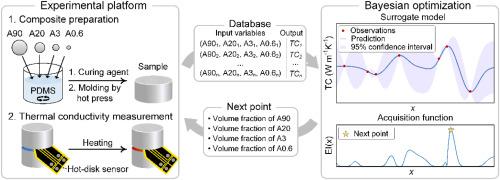Data-driven engineering and analysis of polymer composites with high thermal conductivity
IF 9.8
1区 材料科学
Q1 MATERIALS SCIENCE, COMPOSITES
引用次数: 0
Abstract
The inherent stochastic nature of the structure–property relationships in polymer composites has long posed a challenge, making accurate prediction and optimization nearly impossible. To address this issue, a data-driven engineering approach is presented for designing polymer composites with exceptionally high thermal conductivities (TCs) using polydimethylsiloxane and spherical alumina particles as the model matrix and filler, respectively. Bayesian optimization is performed to determine the optimal composition of spherical alumina fillers with average diameters of 90, 20, 3, and 0.6 μm. The resulting composite exhibits optimized filler packing and a TC of approximately 6.89 W m−1 K−1, surpassing previously reported values. High-resolution 3D X-ray computed tomography combined with quantitative structural analysis further reveals that microstructural features, such as particle connectivity and interfacial characteristics, critically influence the TC of the composite. These findings highlight the effectiveness of machine learning–driven optimization and advanced imaging techniques in capturing the probabilistic nature of composite behavior, enabling the development of high-performance thermal interface materials with enhanced TC, mechanical strength, and reduced thermal expansion.

高导热聚合物复合材料的数据驱动工程与分析
聚合物复合材料结构-性能关系固有的随机性长期以来一直是一个挑战,使得准确的预测和优化几乎是不可能的。为了解决这一问题,提出了一种数据驱动的工程方法,分别使用聚二甲基硅氧烷和球形氧化铝颗粒作为模型基体和填料来设计具有超高导热系数(TCs)的聚合物复合材料。采用贝叶斯优化方法确定了平均直径为90 μm、20 μm、3 μm和0.6 μm的球形氧化铝填料的最佳组成。所得到的复合材料具有优化的填料填料,TC约为6.89 W m−1 K−1,超过了先前报道的值。高分辨率三维x射线计算机断层扫描结合定量结构分析进一步揭示了微观结构特征,如颗粒连通性和界面特征,对复合材料的TC有重要影响。这些发现强调了机器学习驱动的优化和先进的成像技术在捕获复合材料行为的概率性质方面的有效性,从而能够开发具有增强TC、机械强度和降低热膨胀的高性能热界面材料。
本文章由计算机程序翻译,如有差异,请以英文原文为准。
求助全文
约1分钟内获得全文
求助全文
来源期刊

Composites Science and Technology
工程技术-材料科学:复合
CiteScore
16.20
自引率
9.90%
发文量
611
审稿时长
33 days
期刊介绍:
Composites Science and Technology publishes refereed original articles on the fundamental and applied science of engineering composites. The focus of this journal is on polymeric matrix composites with reinforcements/fillers ranging from nano- to macro-scale. CSTE encourages manuscripts reporting unique, innovative contributions to the physics, chemistry, materials science and applied mechanics aspects of advanced composites.
Besides traditional fiber reinforced composites, novel composites with significant potential for engineering applications are encouraged.
 求助内容:
求助内容: 应助结果提醒方式:
应助结果提醒方式:


